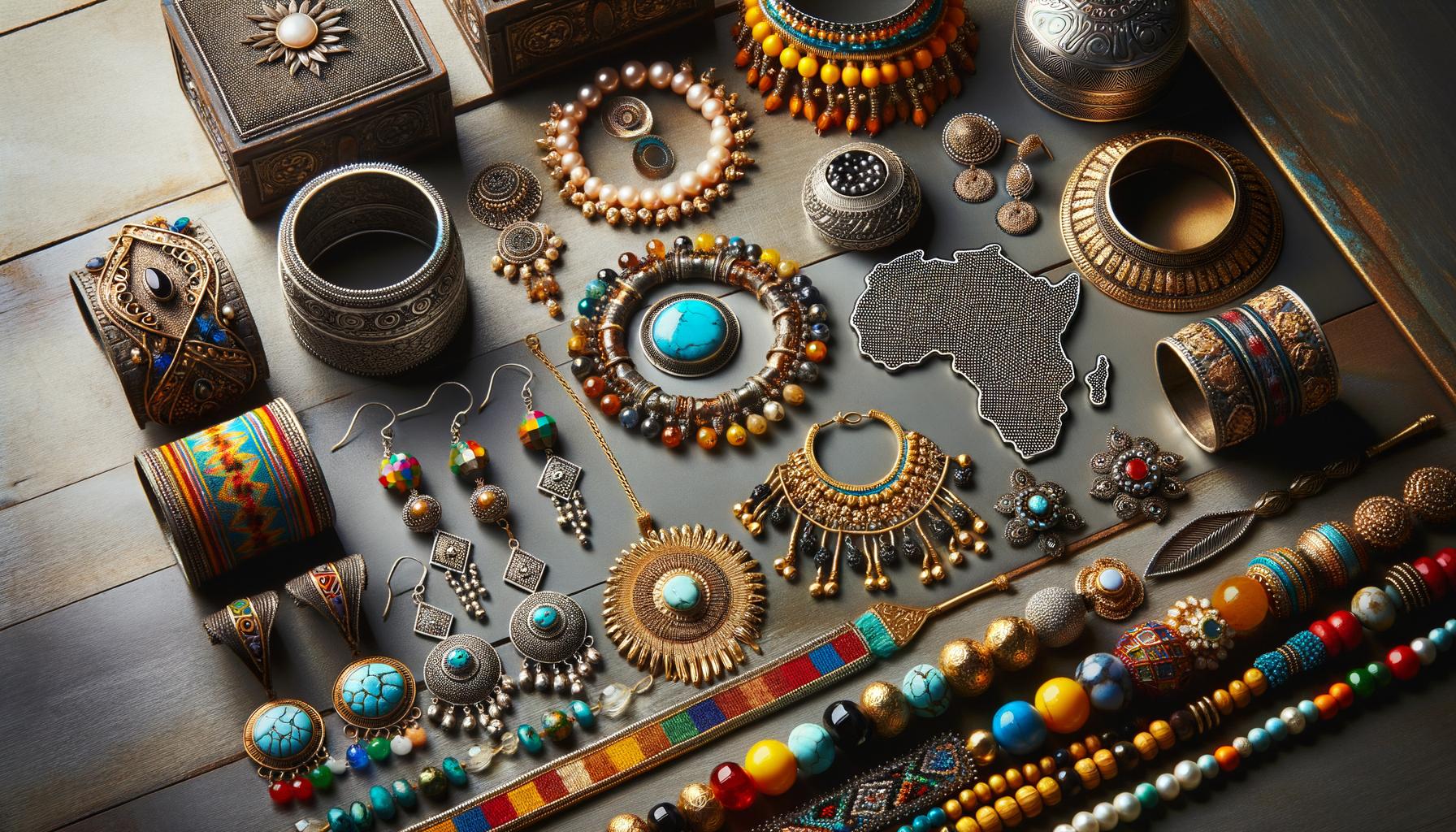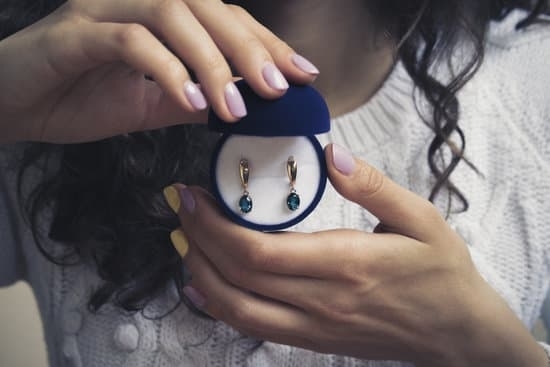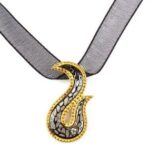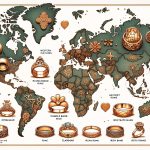Ethnic jewelry: celebrating cultural diversity is more than just accessorizing; it is a profound reminder of the rich and varied tapestries that make up our global heritage. Each piece of ethnic jewelry carries with it stories, traditions, and symbols that span generations, transcending time and borders. This blog delves into the captivating world of ethnic jewelry, examining its deep-rooted significance and the myriad ways it honors and preserves cultural legacies across the globe.
Jewelry has always been an integral part of human culture, serving not merely as adornment but as a medium to convey social status, spiritual beliefs, and community identity. In a rapidly globalizing world where cultures frequently intersect, ethnic jewelry plays a vital role in celebrating cultural diversity. By appreciating and showcasing these intricate designs, we acknowledge themes of heritage and identity that are still relevant today.
In this exploration of ethnic jewelry, we will traverse through history, examining ancient civilizations’ contributions to contemporary designs. We will uncover the distinct materials and techniques unique to various cultures worldwide-from African beadwork to Asian metalcrafts to American Indigenous stonework-and delve into the symbolism behind these stunning pieces.
With an eye on modern fashion trends, we’ll also explore how today’s designers are innovating by blending traditional elements with contemporary flair. Finally, practical tips on incorporating ethnic jewelry into your everyday wardrobe await you, ensuring that every piece you wear continues to celebrate our shared humanity’s rich cultural mosaic.
The Rich History of Ethnic Jewelry
Ethnic jewelry holds a storied past, with origins that can be traced back to ancient civilizations. The Egyptians, for instance, adorned themselves with intricate necklaces, bracelets, and earrings as early as 4000 BCE. These pieces not only served as symbols of social status but also held religious and protective meanings.
The use of gemstones like turquoise and lapis lazuli was prevalent, signifying royalty and divine connection. Similarly, the Mesopotamians crafted jewelry from gold and silver, embedding them with precious stones to signify power and prosperity.
The influence of ancient civilizations on modern ethnic jewelry designs is unmistakable. Indian ethnic jewelry boasts a rich tradition echoing the grandeur of the Mughal empire, where elaborate techniques such as Kundan (a gem-setting technique) were refined.
These designs have transcended time, finding their place in contemporary fashion while still holding onto their cultural roots. Byzantine civilization also left an indelible mark on ethnic jewelry through its fusion of Eastern and Western styles, incorporating intricate patterns that remain popular today.
Key historical milestones have shaped the evolution of ethnic jewelry in many ways. For example, during the Renaissance period in Europe, there was a revival in the interest in classical antiquities which greatly influenced jewelry designs across the continent. In Africa, trade routes established during medieval times facilitated an exchange of materials and aesthetics between different tribes and regions.
This intermingling led to the development of vibrant ethnic jewelry practices that reflected both local traditions and external influences. Such historical context enriches our understanding of these beautiful adornments; each piece tells a story woven through generations while celebrating cultural diversity-ethnic jewelry: celebrating cultural diversity indeed becomes a living testament to human heritage across various epochs.
Varieties of Ethnic Jewelry Across the World
African ethnic jewelry offers a fascinating insight into the continent’s rich tapestry of cultures, tribes, and histories. The materials used range from locally sourced metals such as gold and copper to natural elements like bones, shells, and beads.
For example, Maasai jewelry is known for its vibrant beadwork, often incorporating specific color patterns that convey messages about the wearer’s age, social status, or marital status. Similarly, Tuareg silver jewelry serves not just as an adornment but also as a form of portable wealth and protection against evil spirits.
Additionally, Asian ethnic jewelry reflects a wide array of cultures and traditions that span several millennia. In India, traditional pieces such as the “bindi” and “mangalsutra” are deeply rooted in cultural and religious symbolism. These items are often crafted using intricate techniques like Kundan (gem setting) or Meenakari (enamel work), highlighting the extraordinary craftsmanship inherent in Indian ethnic jewelry. Japanese ethnic ornaments like “netsuke” or “kanzashi” hairpins also have their own unique stories and artistry embedded within them.
European ethnic jewelry encompasses both ancient relics and modern reinterpretations of historical designs. Celtic knots symbolize eternity and interconnectedness; these designs have been passed down through generations in regions like Ireland and Scotland. Traditional Russian pieces might include intricate enamel work known as “Rostov finift,” which dates back to medieval times. In Italy, Venetian glass beads have been cherished for centuries not only for their beauty but also for the skill required to produce them.
American Indigenous jewelry holds a profound connection to nature and ancestral lineage through its use of materials such as turquoise, silver, leather, and feathers. Navajo silversmiths create stunningly detailed concho belts and squash blossom necklaces that embody both excellent craftsmanship and spiritual significance. Native American beadwork often tells stories through complex patterns handed down from one generation to another.
Ethnic Jewelry: Celebrating Cultural Diversity is essential because each region’s unique take on adornments showcases different aspects of human history, culture, religion, socio-economic conditions, and artistic evolution:
- Materials: Vary from precious metals like gold to natural resources such as wood or seeds.
- Techniques: Hand-forging in Africa versus Kundan setting in Asia.
- Symbols: Each piece often carries meanings related to identity or spirituality.
Materials and Techniques Distinct to Ethnic Jewelry
Ethnic jewelry is renowned for its use of varied, often region-specific materials that lend each piece a distinctive character. In African cultures, for example, materials such as gold, silver, and brass are highly prized and often employed in crafting intricate pieces.
Beads made from glass or clay add color and texture, carrying with them symbolic meanings like fertility, wealth, or social status. Similarly, coral beads and cowrie shells are frequently used in African ethnic jewelry to represent prosperity and protection.
Asian ethnic jewelry showcases the rich heritage of different countries within the continent. India is famous for its use of precious stones like diamonds, rubies, sapphires, and emeralds intricately set in gold using techniques such as Kundan or Meenakari work.
Such craftsmanship reflects not just aesthetic preferences but also spiritual beliefs and regional identities. Japanese jewelry often incorporates pearls sourced from local waters along with lacquered wood and unique metals like shakudo (a copper-gold alloy), creating pieces that signify harmony and balance through understated elegance.
| Region | Materials Used |
|---|---|
| Africa | Gold, silver, brass, glass beads, clay beads. |
| Asia (India) | Diamonds, rubies, sapphires, emeralds. |
| Asia (Japan) | Pearls, lacquered wood, shakudo. |
Distinct techniques are pivotal to ethnic jewelry: celebrating cultural diversity is deeply rooted in these practices. Hand-forging metalwork is prevalent in numerous cultures; artisans use this ancient technique to create intricate designs and textures on metals which become timeless keepsakes.
In Native American traditions particularly among the Navajo tribe-silversmithing combined with turquoise stone setting has been elevated to an art form. Techniques like beadwork and weaving are also central to many Indigenous communities worldwide-where each pattern woven into tassels or bracelets carries ancestral knowledge passed down through generations.
Incorporating sustainability has also become a key aspect in modern interpretations of traditional ethnic jewelry. Many contemporary designers consciously source ethical materials that align with environmental conservation efforts while still honoring their cultural roots. For instance, recycled metals are becoming popular alternatives to mined ones while still allowing the creation of meaningful pieces steeped in tradition.
Through the diverse materials used-from precious stones to everyday objects-and the meticulous crafting techniques-such as hand-forging or bead weaving-ethnic jewelry continues to be a profound celebration of humanity’s rich cultural tapestry.
Symbolism and Meaning in Ethnic Jewelry
Cultural and Spiritual Significance
Ethnic jewelry plays a profound role in representing cultural and spiritual beliefs across various communities. In many African societies, for example, jewelry is not just ornamental but also deeply symbolic. Masks adorned with intricate beadwork are often used in ceremonies to honor ancestors or to signify rites of passage. This form of ethnic jewelry: celebrating cultural diversity, serves as both a commemorative artifact and a medium for passing down traditions through generations.
In Asian cultures such as India and China, the use of ethnic jewelry extends far beyond its aesthetic appeal. Jewelry pieces like bangles, nose rings, and anklets are often imbued with spiritual significance.
For instance, the Indian “mangalsutra” is much more than a necklace; it symbolizes marital status and eternal love between spouses, often carrying blessings from elders and being crafted with specific symbols to ward off evil spirits. These culturally significant adornments not only celebrate individuality but also embody collective community values.
Common Symbols and Their Meanings
Various symbols incorporated in ethnic jewelry hold unique meanings that transcend their visual charm. The Hamsa hand in Middle Eastern cultures is a symbol of protection, believed to bring good fortune and deflect negative energies.
This motif is frequently found in necklaces, bracelets, and wall hangings as an emblem of divine safeguarding. Similarly, Native American tribes utilize the dreamcatcher symbol within their jewelry-making traditions to guard against nightmares while encouraging pleasant dreams; this design showcases how deeply interconnected art can be with beliefs about life’s mystical forces.
Europe’s diverse ethnic groups also have rich symbolism woven into their traditional jewelry pieces. The Celtic knot is prominent among Irish heritage items-a continuous loop that signifies eternity whether it pertains to loyalty, faith, friendship, or love. These intricate designs are often featured in rings and pendants handed down through families as heirlooms that carry both personal sentimentality and broader clan identity.
Expression of Identity
Ethnic jewelry holds immense power in communicating identity across different cultures worldwide. Often worn during significant life events such as weddings or festivals, these pieces serve as markers of social status or tribal affiliation. For instance, Maasai necklaces are intricately designed with colorful beads that indicate age grades and social roles within the community-each color has an explicit meaning tied to their way of life.
In Indigenous American cultures like those of the Navajo tribe, turquoise stone used in jewelry symbolizes health, protection, prosperity, and spiritual connectivity with the Earth-a key aspect defining the wearer’s ancestral lineage and relationship with nature. By wearing such culturally resonant items daily or on special occasions individuals not only express pride in their heritage but also reinforce communal bonds through shared meaningful adornment practices.
Modern Adaptations of Ethnic Jewelry
Contemporary designers are finding innovative ways to infuse ethnic elements into modern jewelry styles, creating pieces that honor tradition while appealing to current fashion sensibilities. Modern adaptations have not only rejuvenated interest in ethnic jewelry: celebrating cultural diversity but also ensured the preservation and relevance of traditional designs. Designers often draw inspiration from various cultures and eras, combining them into unique forms that cater to today’s tastes.
The role of ethnic jewelry in today’s fashion industry cannot be understated. High-profile designers and influencers often showcase these pieces on global platforms such as runways, fashion magazines, and social media. This exposure helps highlight the intricacy and beauty of ethnically inspired designs. Additionally, collaborations between contemporary designers and traditional artisans bring authenticity to modern collections while offering a sustainable way to promote cultural heritage.
Examples of fusion jewelry that blend traditional and modern themes are abundant. For instance, integrating African beadwork or Asian metalwork with minimalist Western design creates a sophisticated look that resonates with a broad audience. Similarly, layering American Indigenous craftsmanship with sleek European aesthetics results in creations that breathe new life into ancient techniques.
| Designer | Technique |
|---|---|
| African Beadwork | Mixed with Minimalist Western Design |
| American Indigenous Craftsmanship | Layered with Sleek European Aesthetics |
The Role of Ethnic Jewelry in Cultural Identity and Heritage
Ethnic jewelry plays a fundamental role in the preservation and celebration of cultural identity and heritage. These pieces often carry deep meanings, passed down through generations, capturing the essence of a community’s history, beliefs, and values. Ethnic jewelry: celebrating cultural diversity reminds us that each piece is more than just an accessory; it’s a wearable artifact that tells stories about where we come from and who we are.
For many individuals, ethnic jewelry serves as a tangible connection to their roots, embodying familial traditions and historical continuity. Personal testimonies reveal how people cherish these items not only for their aesthetic appeal but also for their sentimental value. For example:
- A Nigerian bride wearing her mother’s intricately beaded necklace on her wedding day.
- A Native American elder passing down hand-crafted turquoise earrings to her granddaughter.
- An Indian woman draping herself in a gold necklace with intricate filigree that has been part of family celebrations for centuries.
The impact of globalization poses both challenges and opportunities for the preservation of ethnic jewelry traditions. On one hand, widespread global trade can lead to the commercialization and homogenization of traditional designs, potentially diluting their unique cultural significance. However, globalization also facilitates cross-cultural exchange and appreciation. By supporting artisans through fair trade practices and advocating for ethical purchasing decisions, consumers can help ensure that traditional crafting techniques and materials continue to thrive.
How to Incorporate Ethnic Jewelry Into Your Wardrobe
Tips for Styling Ethnic Jewelry With Modern Outfits
Incorporating ethnic jewelry into your everyday wardrobe can be a stylish way to celebrate cultural diversity while adding unique elements to your look. One of the easiest ways to start is by pairing bold ethnic statement pieces with minimalist attire.
For example, a vibrant Maasai beaded necklace can instantly elevate a plain white tee and jeans outfit, transforming a simple look into something extraordinary. Similarly, incorporating metallic Moroccan bangles or a chunky Ethiopian cross pendant can infuse everyday ensembles with rich cultural significance.
Another effective styling tip is to balance the boldness of ethnic jewelry with modern accessories and clothing. If you’re donning an intricately designed Indian Kundan necklace set, consider wearing it over a sleek black dress or balancing the richness with contemporary earrings or bracelets. This approach not only keeps the focus on the stunning ethnic piece but also ensures that your overall look remains cohesive yet distinctive.
Understanding Cultural Appropriation vs. Cultural Appreciation
While embracing ethnic jewelry: celebrating cultural diversity is enriching, it’s crucial to differentiate between cultural appreciation and appropriation. Cultural appreciation involves respecting and honoring the traditions from which these beautiful pieces originate, such as understanding their historical context and significance. Before wearing any ethnic jewelry item, take time to research its background and meaning to ensure that you are celebrating it appropriately rather than inadvertently causing offense.
On the other hand, cultural appropriation occurs when elements of one culture are taken out of their original context-often without permission-and used in another culture’s style for fashion purposes alone, disregarding their intended significance. For instance, wearing Native American sacred symbols as mere fashion statements can be seen as disrespectful unless done thoughtfully and respectfully.
Ethical Considerations When Purchasing Ethnic Jewelry
Supporting artisans who create authentic ethnic jewelry is another important aspect of celebrating cultural diversity through fashion. Ethical considerations should play a key role when purchasing such items; this includes buying from reputable sources that prioritize fair trade practices. Fairtrade organizations ensure that the craftspeople earn decent wages and work under humane conditions.
Additionally, many communities rely on natural resources for creating their traditional jewelry. Ethical purchasing not only supports these artisans but also promotes sustainable use of materials like local stones, reclaimed metals, or eco-friendly beads. By supporting fair trade practices and ethical brands dedicated to sustainability, you contribute to preserving both ancient crafting techniques and natural resources essential for producing magnificent ethnic pieces.
Conclusion
Ethnic jewelry serves as a powerful medium for promoting cultural diversity and understanding. Each piece of ethnic jewelry carries with it centuries of tradition, storytelling, and craftsmanship, reflecting the unique heritage of its origin. By wearing or displaying ethnic jewelry, individuals can express their appreciation for different cultures and contribute to a global tapestry of diversity.
The process of embracing and preserving cultural diversity through ethnic jewelry is not just about aesthetic appeal; it involves recognizing and honoring the artisans who create these pieces. Understanding the history, symbolism, and techniques behind each design fosters a deeper connection to the culture it represents. By supporting fair trade practices and ethical sourcing when purchasing ethnic jewelry, consumers ensure that traditional artisans are fairly compensated for their work, helping to sustain these important cultural practices.
Furthermore, incorporating ethnic jewelry into modern fashion provides an opportunity to celebrate cultural diversity daily. When paired thoughtfully with contemporary outfits, ethnic jewelry pieces can serve as meaningful statements that transcend mere decoration. This blending of old and new highlights the dynamic nature of culture itself-constantly evolving while rooted in rich traditions. Embracing ethnic jewelry: celebrating cultural diversity helps create a more inclusive world where every culture’s artistry is valued and celebrated.
Additional Resources
In conclusion, ethnic jewelry serves as a beautiful and profound way to celebrate cultural diversity across the globe. This intricate art form is far more than just decorative; it is a storytelling medium that conveys the rich histories, traditions, and identities of various cultures. By understanding the origins, materials, symbolism, and contemporary adaptations of ethnic jewelry, we gain deeper appreciation and respect for the artisans and communities who create these stunning pieces.
Embracing ethnic jewelry is about embracing cultural heritage and recognizing the shared humanity that connects us all through these exquisite creations. Each piece tells a story imbued with meaning-whether it’s an African beaded necklace symbolizing unity or an intricate Asian bracelet signifying prosperity. Wearing ethnic jewelry allows us to physically carry a piece of someone’s cultural legacy while also broadening our own perspectives.
As we continue to celebrate and preserve ethnic jewelry traditions amidst globalization’s ever-changing landscape, it becomes crucial to approach this appreciation thoughtfully. Supporting fair trade practices and ethical artisans ensures these beautiful traditions endure for future generations. So whether you’re incorporating ethnic jewelry into your wardrobe or simply admiring from afar, let it serve as a reminder of the vibrant tapestry of cultures that enrich our world every day.
Frequently Asked Questions
What Is the Meaning of Ethnic Jewelry?
Ethnic jewelry refers to adornments that originate from specific cultures and regions, encapsulating the historical and cultural essence of those societies. These pieces often carry traditional symbols, motifs, and craftsmanship techniques passed down through generations.
They can include materials native to the region, such as stones, metals, and beads unique to a particular culture’s geography. The intricate designs and significance behind each piece help preserve heritage and share storied traditions with the world.
What Is Celebrating Cultural Diversity?
Celebrating cultural diversity means recognizing, respecting, and appreciating the rich array of different cultures within a community or society. It involves acknowledging the unique customs, beliefs, languages, artistic expressions, and lifestyles that various groups contribute to the collective identity.
This celebration fosters inclusiveness by creating an environment where multiple perspectives are valued equally. Through festivals, educational programs, art exhibitions, and more, people can learn from one another’s backgrounds and build mutual understanding and respect.
How Does Jewelry Represent Culture?
Jewelry represents culture in multifaceted ways by embodying significant symbols, historical narratives, social statuses, religious beliefs, and identities of a community. For instance, certain elements in jewelry design might indicate marital status or social ranking within that culture.
Additionally, some pieces are used in rituals or ceremonies preserving ancestral customs while others serve as daily reminders of a person’s heritage. The materials sourced for these items often have cultural relevance too; for example pearls are significant in Chinese culture symbolizing purity while turquoise is cherished by Native American tribes for its protective qualities.

Welcome to my jewelry blog! My name is Sarah and I am the owner of this blog.
I love making jewelry and sharing my creations with others.
So whether you’re someone who loves wearing jewelry yourself or simply enjoys learning about it, be sure to check out my blog for insightful posts on everything related to this exciting topic!





